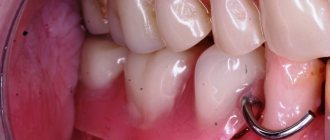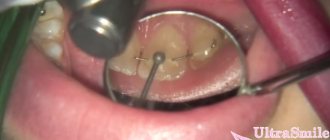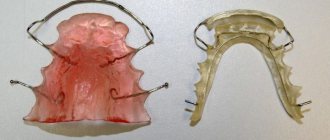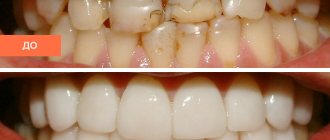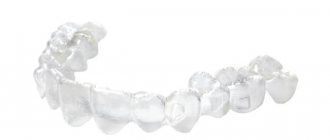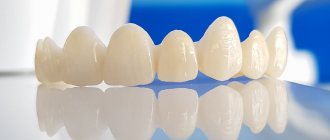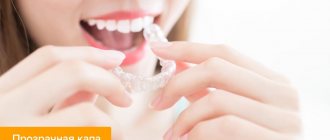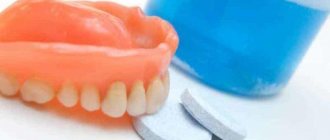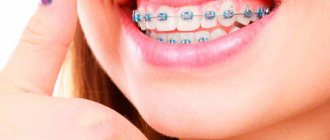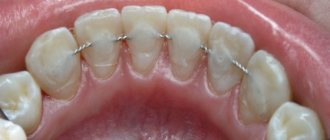Publication date: June 01, 2022.
Date the information on this page was updated: January 21, 2022.
Orthodontic treatment does not end with the removal of braces, because immediately after removal, the bone tissue and ligaments will begin to return to their original position and move the teeth. To consolidate the result after removing braces, it is necessary to install retention structures that will hold the teeth in the correct position until the bone tissue is finally formed around the roots of the teeth.
- What are retainers?
- Fixed retainers
- Removable retainers and mouthguards
- Combined
- How do retainers work?
- How long should retainers be worn?
- The process of installing permanent retainers
- How to care for retainers?
- Which is better: mouthguards or retainers?
- Frequently asked questions about retainers
- What problems can arise with a retainer?
- Reviews about retainers
Fixed retainers
A permanent retainer is a wire arch made of medical steel, which is attached to the inside of the teeth with a special compound. This type of retainer is used most often, as they are completely invisible, cannot be felt in the mouth and do not oxidize. Fixed retainers can come off due to mechanical stress, such as chewing hard food. In this case, you should immediately visit the orthodontist and return the retainer to its place to prevent the teeth from moving.
Fixed retainers have many advantages: you can’t forget to put them on - they are always on your teeth, and they are absolutely invisible and do not interfere. The main feature of wearing a fixed structure is the need for careful home hygiene and professional cleaning every six months at the dentist, since plaque in hard-to-reach places around the retainer is more difficult to clean.
Ligature metal systems
In dentistry, this design is the main one for correcting malocclusion. The ligature in braces are additional elements, wires or elastic bands, with which they are attached to the arch. During a planned replacement, you can choose rubber bands of a different color each time - they are available for sale in a large assortment. You can wear elastic bands of different colors at the same time. Nowadays, orthodontic systems on teeth no longer cause embarrassment for children and teenagers: ligatures for braces even act as a fashion accessory.
In general, ligature systems are a classic of orthodontics. They are made from all types of materials:
- metal - the most inexpensive and optimal in cost;
- ceramic - braces made of this material can be matched exactly to the color of the enamel, and they will be almost invisible on the teeth;
- Sapphire braces are made from artificially grown sapphires, they are transparent, considered the most aesthetic, unlike metal ones, but the most expensive in price.
Elastic bands in ligature systems need to be changed regularly, because they wear out over time - about once a month. But wire ring ligatures are changed much less frequently. Let's consider the features of these structures.
Removable retainers and mouthguards
Removable retention structures come in two types:
- Plastic plates with a metal arch that encircles the dentition;
- Transparent mouth guards made of silicone.
After braces are removed, mouthguards or plates must be worn constantly, removed only during meals, brushing teeth, or public speaking. In the future, on the recommendation of a doctor, the time of wearing retention structures is reduced: they are removed at night and worn less during the day. Removable structures can be noticeable to others, and at first they affect diction and cause increased salivation. Typically, removable retainers are prescribed at the end of the retention period after fixed structures, but they can also be used independently throughout the entire retention period.
Plastic plates with metal arc
Silicone transparent mouth guard
How do retainers work?
Braces or aligners actively move teeth in the desired direction due to the traction of the arch and pressure on the dentition. A non-removable wire retainer does not put pressure on the teeth, but only holds them in the desired position, preventing them from moving apart. Removable aligners differ from aligners in that they are not used with attachments (activators of tooth movement), but exactly repeat the shape of the dentition and fit tightly to the teeth, fixing the dentition. Any retention structure does not move the teeth, but at the same time it should prevent the ligaments from relaxing and returning to their previous position until the bone tissue around is completely strengthened.
How long should retainers be worn?
The duration of the retention period is on average 2 times longer than wearing braces, and patients who corrected their bite in adulthood - after 25-30 years, can wear retainers all their lives.
The length of time you wear retainers usually varies from person to person and depends on the following factors:
- Age of the orthodontic patient. The younger a person is, the faster his ligaments and muscles are rebuilt, thereby fixing the teeth and bite in the correct position. For patients who received braces as teenagers, wearing retainers for 6 months to 2 years is sometimes sufficient.
- Bad habits. People who smoke have poor blood supply and reduced immunity, so all processes of restructuring the position of teeth and healing are slower than in non-smokers.
- Oral health. If the teeth and periodontal tissues are healthy, the fixation of the ligamentous apparatus occurs faster.
- Complexity of the clinical case. The stronger the initial curvature of the teeth, the longer you need to wear a retainer.
The retention period must be carried out under the supervision of an orthodontist so that he monitors the condition of the bite. In any case, you should not stop wearing retainers without your doctor's approval, otherwise your teeth may become crooked again.
How much does it cost to replace an archwire on a bracket system?
All brace systems require individual adjustments, tensioning and arch replacement. The cost of replacing a vestibular element in clinics in Moscow and St. Petersburg averages from 2,000 rubles, and a lingual element from 3,500 rubles. If the structure breaks down, the price for repairs, installation and activation of the leveling wire is calculated individually.
The cost of the procedure can be influenced by the system manufacturer:
- replacement of the arc with Ormco – 2500 rubles;
- replacement with 3M Unitec structures - 2800 rubles;
- replacement with American Orthodontics braces - 2900 rubles.
The process of installing permanent retainers
Retainers are installed after braces are removed on completely healthy teeth after professional hygiene. The patient may need to undergo oral sanitation after orthodontic treatment. While wearing braces, it is difficult to clean your teeth perfectly, and accumulated plaque can cause caries and tartar. Retainers cannot be installed on affected teeth, since another design in the mouth will again complicate hygiene and lead to a deterioration in the condition of the oral cavity. Also, during orthodontic treatment, the enamel may become thinner, so in addition to hygienic cleaning, teeth need fluoridation and mineralization.
After carrying out therapeutic and preventive measures, the orthodontist begins the laboratory stage of manufacturing retainers. An impression is taken from healthy teeth, according to which the retainer is given the necessary shape of the dentition.
Before the actual installation of the retainer, the teeth are etched with a special solution so that their surface becomes slightly rougher for better adhesion. In some cases, instead of etching the teeth, the teeth are prepared: a microgroove is drilled on the inside to fix the retainer. Once the teeth are prepared, the retainer is placed in the desired position and secured with composite material. The procedure is completed by grinding the material for the patient’s convenience.
The installation procedure takes 15-20 minutes and is absolutely painless. But in the first days of adaptation, the retainer can rub and reduce the clarity of diction.
Pros and cons of ligature braces
These systems have their advantages and disadvantages, which the patient should be aware of before installation. Here are the advantages of these braces:
- Effectiveness: the use of ligatures allows you to reduce the period of wearing the system as a whole;
- a wide range of dental pathologies for which ligature braces are used;
- optimal cost - metal braces are especially affordable in price, although they do not look as aesthetically pleasing as ceramic or sapphire ones;
- the ability to change the system visually using rubber band ligatures of different colors.
Along with these undoubted advantages, ligature braces have their own characteristics:
- the need for constant correction: when installing elastic bands, you need to visit the orthodontist once a month to replace them;
- metal hard elements can cause some discomfort and long-term addiction;
- white or light-colored rubber bands can be stained by food; you will need to follow a certain diet.
But in general, despite some disadvantages, ligature braces provide good results in correcting malocclusion and are used more often than non-ligature or self-ligating braces. Let's consider this type of orthodontic structures.
How to care for retainers?
Retainers, like any structure in the mouth, without careful hygiene provoke the accumulation of bacteria, the appearance of plaque and caries.
- You can brush your teeth with a regular toothbrush and toothpaste, but be careful when brushing the inside of your teeth if you have a permanent retainer;
- If the retainer comes unstuck, you need to visit the orthodontist and return it to its place so that an orthodontic relapse does not occur;
- For thorough hygiene when wearing fixed retainers, it is recommended to use a waterpik, brushes and dental floss to clean hard-to-reach places near the arch;
- Removable retainers and mouth guards should be washed with disinfectants, soap, or brushed with toothpaste at least 2 times a day.
- Mouthguards must be removed when eating and smoking and stored in special containers;
- Mouthguards should not be washed with hot water because they will become deformed.
- To strengthen the enamel, it is recommended to rinse the mouth with a fluoride solution.
After braces are removed and retainers are installed, you should periodically visit the orthodontist for follow-up examinations and the hygienist to maintain oral health. Only after the end of the retention period can orthodontic treatment be considered complete.
Features of non-ligature braces
The fastening of the power arc in this type of design is carried out using miniature locks or clips with grooves glued to the bracket plates. The arc is inserted into the grooves and snaps into place. The absence of blocking allows the arc to move freely in the grooves. This significantly reduces the feeling of discomfort when wearing. The forceful effect occurs naturally; the system itself ligates the process, which is why it is also called self-ligating.
Which is better: mouthguards or retainers?
Retention mouthguards and a non-removable retainer after orthodontic treatment are used in combination: a non-removable retainer from canine to fang is permanently placed on the teeth, the mouthguard is put on at night. After removing braces, we give patients 2 mouthguards: a night guard for all teeth in the upper dentition and a canine-to-canine safety mouthguard for the lower dentition, which is needed if the retainer breaks and there is no way to quickly make an appointment with an orthodontist. From the point of view of patient comfort, a non-removable retainer is more convenient than a mouth guard, since a week after installation, it is practically not felt in the mouth. And the mouth guards are quite bulky and it’s more difficult to get used to them.
Frequently asked questions about retainers:
Typically, patients who are thinking about installing braces learn about the need to wear a retainer during a consultation with an orthodontist. We have collected the most common questions that patients ask about the retention period.
How long to wear a retainer?
The minimum period for an adult patient is twice as long as the period of orthodontic treatment. Our recommended period is from 5 to 10 years, depending on the complexity of the case and the type of retention. Many patients do not feel the retainer on their teeth and quietly wear it all their lives.
Is it possible to do an MRI with a retainer?
Yes, an MRI can be done with a retainer, just like with braces, but due to the presence of metal in the mouth, there may be interference in the final image.
Do I need to change my permanent retainer?
If the retainer is not broken or unstuck, then there is no need to change it. To maintain good hygiene in the retainer area, use a single-tuft brush, brushes, dental floss, and regular professional hygiene.
Is there a warranty for the retainer?
In our clinic, the warranty on the retainer lasts 2 years. If during this time the retainer breaks or comes off, we will replace it absolutely free of charge.
Can teeth move apart if a retainer is installed?
If orthodontic treatment is completed correctly - the correct closure and position of the teeth is achieved, then with a permanent retainer, the teeth will remain in the correct position. If the retainer comes unstuck or breaks, you need to install it as quickly as possible, since even in a month your teeth can change position.
Content
- 1 area of use
- 2 Normative references
- 3 Terms and definitions
- 4 Classification
- 5 Requirements
5.1 General provisions
- 5.2 Dimensions
- 5.3 Final temperature of austenite
- 5.4 Mechanical properties
- 5.5 Hazardous elements
- 6.1 Sampling
- 7.1 General requirements
Appendix YES (informative) Information on the compliance of reference standards with national
and interstate standards
NATIONAL STANDARD OF THE RUSSIAN FEDERATION Dentistry
ORTHODONTIC WIRE
Dentistry. Wires for use in orthodontics
Date of introduction: 2018—09—01
What problems can arise with a retainer?
The first thing a person who has a permanent retainer installed will face is getting used to it. At first, the retainer may rub your tongue, feel too big in your mouth, and interfere with clear diction. The retainer becomes invisible in the mouth after about a week.
The next task for a patient with a retainer is careful home hygiene, since food debris can get stuck in the spaces between the teeth and the retainer. For home cleaning, we recommend using a single-tuft brush, brushes, dental floss and irrigator.
The retainer may break or come off due to hard foods. In this case, you need to contact your doctor for a replacement.
If caries appears in the area of the retainers on the teeth, then for treatment by a therapist, the retainer will need to be removed and then reinstalled.
What types of arches are there for braces?
Orthodontic arches differ in different parameters.
According to the shape and diameter of the section
The thinner the cross-section diameter, the thinner and less intense the arc works. Treatment begins with the thinnest arches, as the teeth must get used to the system. At the end of therapy, thick products are placed that completely fill the space in the grooves of the structure.
According to their cross-sectional shape they are:
- round (0.14 - 0.16 inches);
- square (0.16 to 0.175 inches);
- rectangular (0.14-0.25 inches).
Round ones have a less active effect on the process of teeth straightening and are used at the beginning of treatment. The rectangular arch in braces has a medium tension force and is used in the intervals between the use of round and square arches. The square arch has maximum resistance and is installed at the end of therapy.
By purpose and size
According to their purpose, arcs are classified into the following types:
- for upper teeth (Upper);
- for lower teeth (Lower);
- for vestibular braces (standard);
- for lingual braces (individual);
- universal.
The size of the product is selected taking into account the size of the teeth:
- large (Large);
- average (Medium);
- small (Small).
According to the method and material of manufacture
The composition of the alloy used to make the arcs determines the strength, strength and ductility of the wire. The most commonly used materials are:
- stainless steel (SS, D-rect) - the classic, most often used, has a high degree of strength and elasticity, and is affordable;
- titanium and nickel alloy (Ti-Ni) - elastic arcs that exert moderate pressure are used at the beginning of therapy;
- an alloy of titanium, nickel and copper (Cooper Ti-Ni) - ideal for minor bite problems or at the beginning of treatment;
- titanium and molybdenum alloy (TMA) - rigid but quite elastic arches used in the middle and final stages of treatment, rarely cause allergies.
According to the method of making arcs, there are:
- monolithic, made from a single piece of wire - used at the stage of main treatment;
- braided, created from several strands of wire - usually installed at an early stage of correction.
According to the availability of additional functions
In this case, the arcs are divided into the following types:
- with loops for closing interdental spaces caused by the removal of individual teeth;
- with a reversible bend along the curve of Spee, which makes it possible to combine teeth alignment with correction of bite depth;
- with hooks and stops necessary for attaching elastics and springs;
- with torque in the Damon design.
